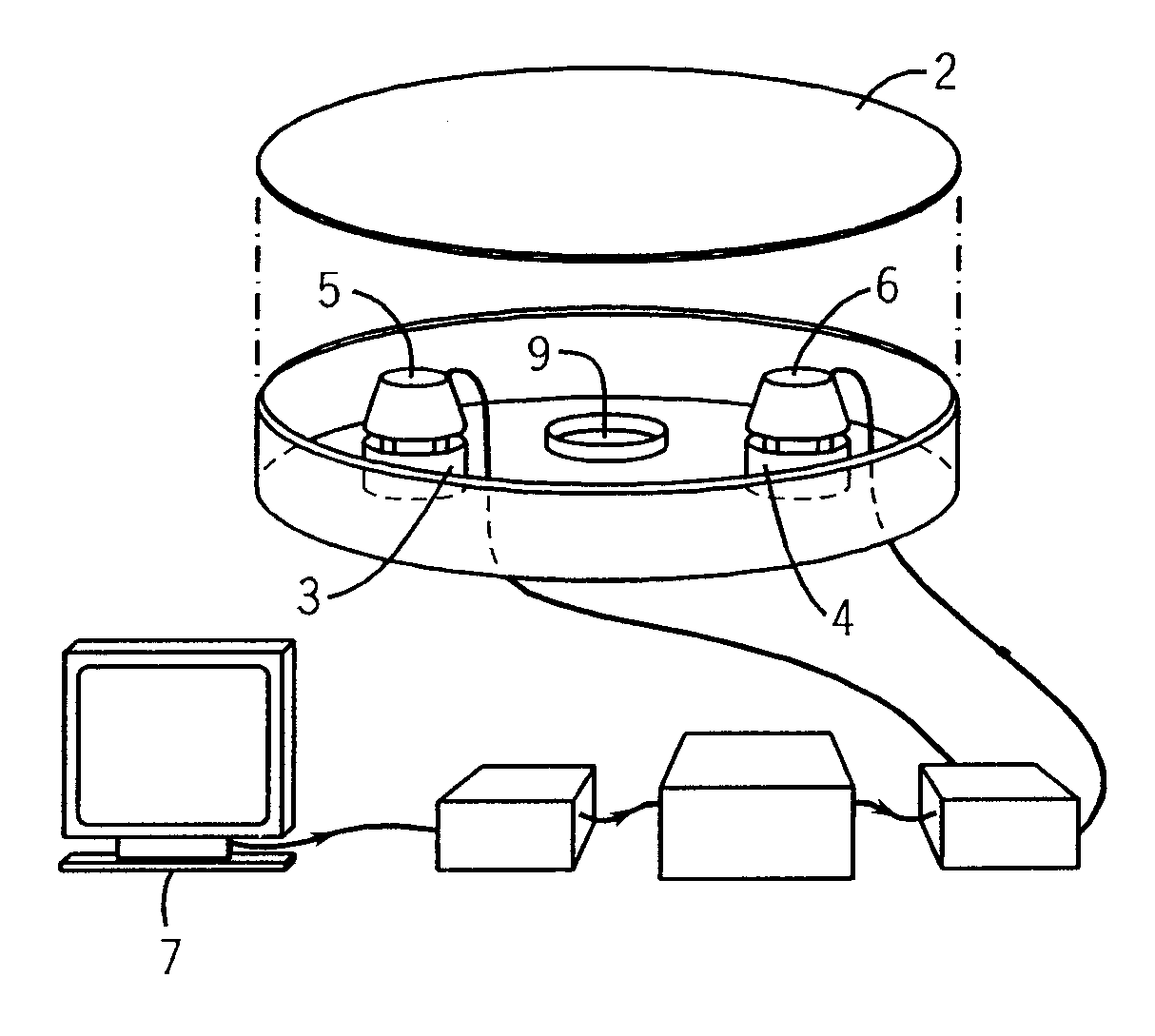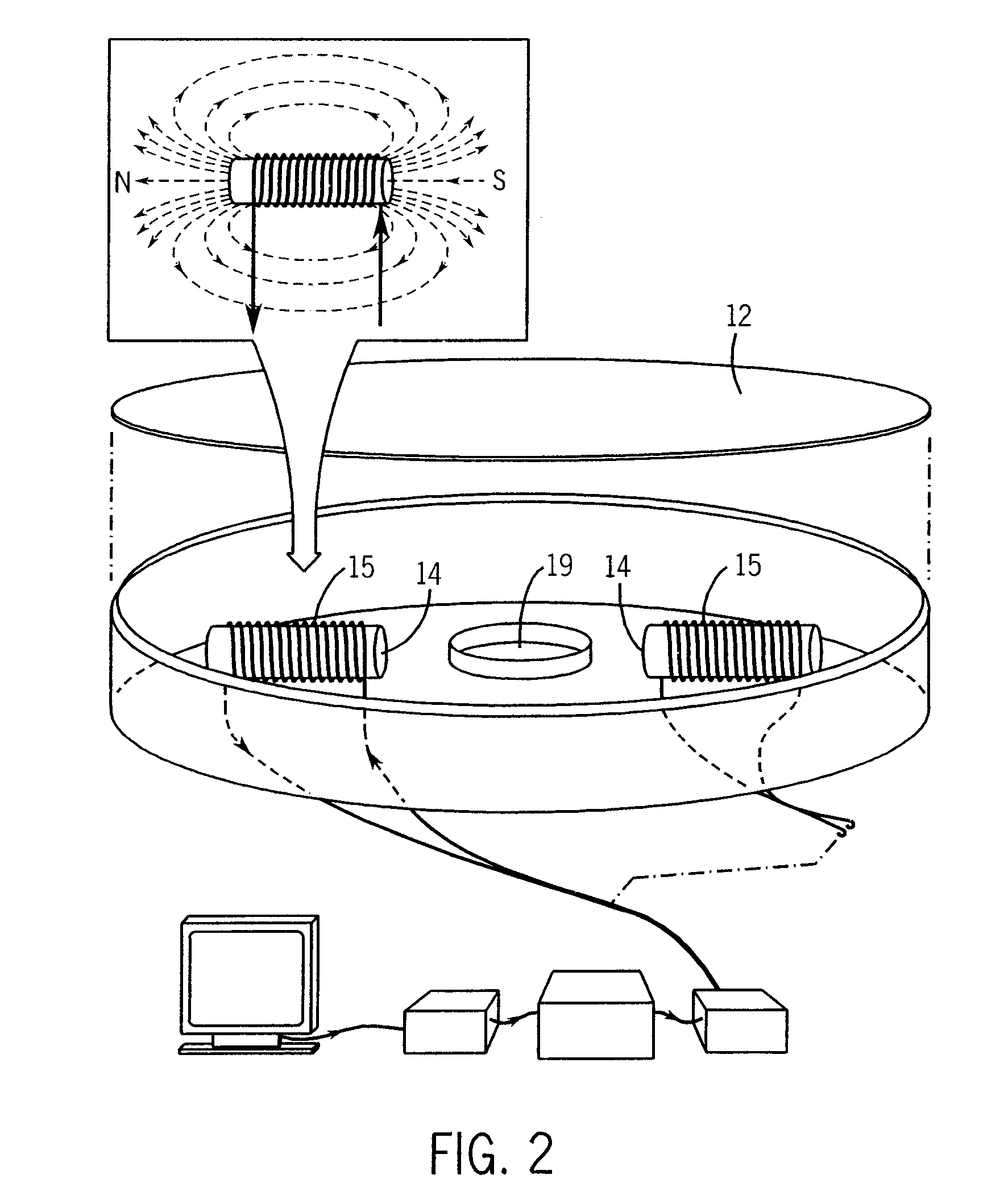Use of electromagnetic fields to affect insect movement
a technology of electromagnetic field and movement, applied in the field of electromagnetic field to affect the movement of insects, can solve the problems of ineffective insecticides, ineffective completely sanitized apartments, and often ineffective insecticides, and achieve the effects of low cost, reduced production costs, and improved insect control
- Summary
- Abstract
- Description
- Claims
- Application Information
AI Technical Summary
Benefits of technology
Problems solved by technology
Method used
Image
Examples
experiment 1
[0041] As depicted in FIG. 1, we exposed female German cockroaches to white noise, and to the electromagnetic field associated therewith. There was a plastic arena 2 in which were placed two “shelters”3 and 4 equidistant from each other and the center. The shelters were constructed from aluminum, albeit they were topped with an inverted plastic cup on props.
[0042] Each cup contained a headphone speaker 5, 6 that was connected to a computer 7 having a white noise generator. A white noise signal (frequency 20-20000 Hz), was sent through relays and amplifiers, and then directed to a selected one of the speakers while the other speaker was left inactive and thus functioned as a control. As a result, during the experiment one of the speakers was emitting a Gaussian white noise auditory signal (±0.5 volts, 55 dB) as well as the associated electromagnetic field, while the other speaker was emitting no auditory signal and no electromagnetic field. The treatment stimulus was alternated betw...
experiment 2
[0045] In experiment 2 (FIG. 2) we used a somewhat similar experimental setup. However, instead of aluminum shelters, two hollow glass cylinders 14 were placed in the arena 12 horizontally and equidistant from each other and the arena center. We use this equipment to test the effect of a low-level alternating current (AC) driven electromagnetic field (without an audible component) for attraction and arrestment of German cockroaches.
[0046] Each cylinder 14 was wrapped in electrical wire 15 (enamel coated, 28 gauge) to create a coil. (resistance: ≈21 ohms, diameter: 4.7 cm). The treatment coil received a Gaussian white noise signal (±0.5 volts) via a computer with a white noise generator (see above). This coil generated an AC-driven electromagnetic field (EMF) (19.
[0047] Experiment 2 revealed that coils associated with AC-driven electromagnetic fields, particularly those 38 shows the mean (+SE) number of insects in coils and horizontal axis 40 shows the treatment. Bar graph 42 indic...
experiment 3
[0048] Using similar experimental procedures to experiment 2, albeit with an electromagnetic field at greater strength (0.05-1 mT) we determined that alternating current electromagnetic fields in this range also was attractive, albeit in this range the insects preferred to aggregate under the coil rather than inside.
[0049]FIG. 8 graphically illustrates numbers of female German cockroaches recorded in experiment 3 in and / or under coils with or without fluctuating AC-driven electromagnetic fields. Vertical axis 46 shows the mean (+SE) number of insects in and / or tinder coils and horizontal axis 48 shows the treatment. Bar graph 50 indicates the mean number of insects in and / or under coils not emitting a fluctuating AC-driven electromagnetic field. Bar graph 52 indicates the mean number of insects in and / or under coils emitting a fluctuating AC-driven electromagnetic. The asterisk indicates a significant preference for the treatment stimulus. ANOVA (arcsin proportion; α=0.05).
PUM
 Login to View More
Login to View More Abstract
Description
Claims
Application Information
 Login to View More
Login to View More - R&D
- Intellectual Property
- Life Sciences
- Materials
- Tech Scout
- Unparalleled Data Quality
- Higher Quality Content
- 60% Fewer Hallucinations
Browse by: Latest US Patents, China's latest patents, Technical Efficacy Thesaurus, Application Domain, Technology Topic, Popular Technical Reports.
© 2025 PatSnap. All rights reserved.Legal|Privacy policy|Modern Slavery Act Transparency Statement|Sitemap|About US| Contact US: help@patsnap.com



